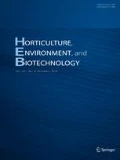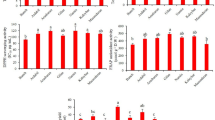Abstract
Phytochemical constituents, such as alliin, vitamin C, total phenol and total flavonoid, content of free sugars, and antioxidant activity of 19 garlic lines and cultivars [six parental lines, three controlled cultivars, five cultivars for regional adaptation test (RAT cultivars), and five new cultivars, released by NIHHS for commercialization] cultivated at the experimental field in the NIHHS, RDA in Suwon were evaluated. Average contents of alliin, vitamin C, total phenol and total flavonoid per 100 g dry weight, respectively, were 1,938.4 mg, 9.3 mg, 97.0 mg gallic acid equivalent (GAE) and 16.1 mg catechin hydrate equivalent (CE), and antioxidant activity was 27.5%. Among the three free sugars analyzed, sucrose was present in the greatest quantity (3.48%), followed by fructose (1.05%) and glucose (0.54%). The RAT cultivars, R-01, R-04 and R-05, and new cultivars released for commercialization, NC-02, NC-03 and NC-04, exhibited statistically greater contents of phytochemicals, and consequently possessed higher antioxidant activities as compared to the parental lines and control cultivars. Total flavonoid content showed the highest positive correlations with antioxidant activity (r = 0.908**), followed by total phenol and vitamin C contents.
Similar content being viewed by others
Literature Cited
Agarwal, K.C. 1996. Therapeutic actions of garlic constituents. Med. Res. Rev. 16:111–124.
Amagase, H. 2006. Clarifying the real bioactive constituents of garlic. J. Nutr. 136:716S–725S.
Aires, A., C. Fernandes, R. Carvalho, R.N. Bennett, M.J. Saavedra, and E.A.S. Rosa. 2011. Seasonal effects on bioactive compounds and antioxidant capacity of six economically important Brassica vegetables. Molecules 16:6816–6832.
Arnault, I., J.P. Christides, N. Mandon, T. Haffner, R. Kahane, and J. Auger. 2003. High-performance ion-pair chromatography method for simultaneous analysis of alliin, deoxyalliin, allicin and dipeptide precursors in garlic products using multiple mass spectrometry and UV detection. J. Chrom. A 991:69–75.
Atashi, S., V. Akbarpour, K. Mashayekhi, and S.J. Mousavizadeh. 2011. Garlic physiological characteristics from harvest to sprouting in response to low temperature. J. Stored Prod. Postharvest Res. 2:285–291.
Banerjee, S.K., P.K. Mukherjee, and S.K. Maulik. 2003. Garlic as an antioxidant: The good, the bad and the ugly. Phytother. Res. 17:97–106.
Beato, V.M., F. Orgaz, F. Mansilla, and A. Montano. 2011. Changes in phenolic compounds in garlic (Allium sativum L.) owing to the cultivar and location of growth. Plant Foods Hum. Nutr. 66:218–223.
Bozin, B., N. Mimica-Dukic, I. Samojlik, A. Goran, and R. Igic. 2008. Phenolics as antioxidants in garlic (Allium sativum L., Alliaceae). Food Chem. 111:925–929.
Cai, Y., R. Wang, F. Pei, and B.B. Liang. 2007. Antibacterial activity of allicin alone and in combination with β-lactams against Staphylococcus spp. and Pseudomonas aeruginosa. J. Antibio. 60:335–338.
Choi, M.K., K.Y. Chae, J.Y. Lee, and K.H. Kyung. 2007. Antimicrobial activity of chemical substances derived from S-alk (en)yl-L-cysteine sulfoxide (alliin) in garlic, Allium sativum L. Food Sci. Biotechnol. 16:1–7.
Chung, L.Y. 2006. The antioxidant properties of garlic compounds: Allyl cysteine, alliin, allicin, and allyl disulfide. J. Med. Food 9:205–213.
Corzo-Martinez, M., N. Corzo, and M. Villamiel. 2007. Biological properties of onions and garlic. Trends Food Sci. Tech. 18:609–625.
Das, N.P. and T.A. Pereira. 1990. Effects of flavonoids on thermal auto-oxidation of Palm oil: Structure-activity relationship. J. Amer. Oil Chem. Soc. 67:255–258.
Fenwick, G.R. and A.B. Hanley. 1985. The genus Allium. Crit. Rev. Food Sci. Nutr. 22:273–377.
Food and Agricultural Organization of the United Nations (FAO). 2011. Crop production garlic FAOSTAT. http://faostat.fao.org/site/339/default.aspx.
Gliszczynska-Swiglo, A., E. Ciska, K. Pawlak-Lemanska, J. Chmielewski, T. Borkowski, and B. Tyrakowska. 2006. Changes in the content of health-promoting compounds and antioxidant activity of broccoli after domestic processing. Food Addit. Contam. 23:1088–1098.
Gorinstein, S., H. Leontowicz, M. Leontowicz, J. Namiesnik, K. Najman, J. Drzewiecki, M. Cvikrova, O. Martincova, E. Katrich, and S. Trakhtenberg. 2008. Comparison of the main bioactive compounds and antioxidant activities in garlic and white and red onions after treatment protocols. J. Agric. Food Chem. 56:4418–4426.
George, S., P. Brat, P. Alter, and M.J. Amiot. 2005. Rapid determination of polyphenols and vitamin C in plant-derived products. J. Agric. Food Chem. 53:1370–1373.
Hounsome, N., B. Hounsome, D. Tomos, and G. Edwards-Jones. 2009. Changes in antioxidant compounds in white cabbage during winter storage. Postharvest Biol. Technol. 52:173–179.
Kaur, C. and H.C. Kapoor. 2001. Antioxidants in fruits and vegetables — The millennium’s health. Int. J. Food Sci. Technol. 36:703–725.
Kim, S.M., K. Kubota, and A. Kobayashi. 1997. Antioxidative activity of sulfur-containing flavor compounds in garlic. Biosci. Biotechnol. Biochem. 61:1482–1485.
Koleva, I.I., T.A. van Beek, J.P.H. Linssen, A. de Groot, and L.N. Evstatieva. 2002. Screening of plant extracts for antioxidant activity: A comparative study on three testing methods. Phytochem. Anal. 13:8–17.
Korean Statistical Information Service (KOSIS). 2012. Agriculture, forestry and fishery survey. KOSIS, Daejeon, Korea.
Kyung, K.H. 2012. Antimicrobial properties of Allium species. Curr. Opin. Biotechnol. 23:142–147.
Miliauskas, G., P.R. Venskutonis, and T.A. van Beek. 2004. Screening of radical scavenging activity of some medicinal and aromatic plant extracts. Food Chem. 85:231–237.
Marinova, D., F. Ribarova, and M. Atanassova. 2005. Total phenolics and total flavonoids in Bulgarian fruits and vegetables. J. Univ. Chem. Tech. Met. 40:255–260.
Marsilio, V., C. Campestre, B. Lanza, and M. DeAngelis. 2001. Sugar and polyol compositions of some European olive fruit varieties (Olea europaea L.) suitable for table olive purposes. Food Chem. 72:485–490.
Masuda, R., K. Kaneko, and I. Yamashita. 1996. Sugar and cyclitol determination in vegetables by HPLC using post column fluorescent derivatization. J. Food Sci. 61:1186–1190.
Mayeux, P.R., K.C. Agrawal, J.S.H. Tou, B.T. King, H.L. Lippton, A.L. Hyman, P.J. Kadowiz, and D.B. McNamara. 1998. The pharmacological effects of allicin, a constituent of garlic oil. Agents Actions 25:182–190.
Naguib, A.E.M.M., F.K. El-Baz, Z.A. Salama, H.A.E.B. Hanaa, H.F. Ali, and A.A. Gaafar. 2012. Enhancement of phenolics, flavonoids and glucosinolates of Broccoli (Brassica olaracea, var. Italica) as antioxidants in response to organic and bio-organic fertilizers. J. Saudi Soc. Agric. Sciences 11:135–142.
Nencini, C., A. Menchiari, G.G. Franchi, and L. Micheli. 2011. In vitro antioxidant activity of aged extracts of some Italian Allium species. Plant Foods Hum. Nutr. 66:11–16.
Nuutila, A.M., R. Puupponen-Pimia, M. Aarni, and K.-M. Oksman-Caldentey. 2003. Comparison of antioxidant activities of onion and garlic extracts by inhibition of lipid peroxidation and radical scavenging activity. Food Chem. 81:485–493.
Picchi, V., C. Migliori, R. Lo Scalo, G. Campanelli, V. Ferrari, and L.F. Di Cesare. 2012. Phytochemical content in organic and conventionally grown cauliflower. Food Chem. 130:501–509.
Pourcel, L., J.M. Routaboul, V. Cheynier, L. Lepiniec, and L. Debeaujon. 2006. Flavonoid oxidation in plants: From biochemical properties to physiological functions. Trends Plant Sci. 12:29–36.
Queiroz, Y.S., E.Y. Ishimoto, D.H.M. Bastos, G.R. Sampaio, and E.A.F.S. Torres. 2009. Garlic (Allium sativum L.) and ready-to-eat garlic products: In vitro antioxidant activity. Food Chem. 115: 371–374.
Rabinkov, A., T. Miron, L. Konstantinovski, M. Wilchek, D. Mirelmen, and L. Weiner. 1998. The mode of action of allicin: Trapping of radicals and interaction with thiol containing proteins. Biochim. Biophys. Acta 1379:233–244.
Rahman, M.S. 2007. Allicin and other functional active components in garlic: Health benefits and bioavailability. Int. J. Food Prop. 10:245–268.
Rice-Evans, C., N.J. Miller, P.G. Bolwell, P.M. Bramley, and J.B. Pridham. 1995. The relative antioxidant activity of plant derived polyphenolic flavonoids. Free Radical Res. 22:375–383.
Rivlin, R. 2001. Historical perspective on the use of garlic. J. Nutr. 131:951S–954S.
Sangwan, A., A. Kawatra, and S. Sehgal. 2010. Chemical composition of garlic powder using different drying methods. Asian J. Home Sci. 5:90–93.
Sendl, A., G. Elbl, B. Steinke, K. Redl, W. Breu, and H. Wagner. 1992. Comparative pharmacological investigations of Allium ursinum and Allium sativum. Planta Med. 58:1–7.
Shin, J.H., S.J. Lee, W.J. Jung, M.J. Kang, and N.J. Sung. 2011. Physicochemical characteristics of garlic (Allium sativum L.) on collected from the different regions. J. Agric. Life Sci. 45:103–114.
Singleton, V.L. and J.A. Rossi, Jr. 1965. Colorimetry of total phenolics with phosphomolybdic-phosphotungstic acid reagents. Amer. J. Enol. Viticult. 16:144–158.
Spinola, V., B. Mendes, J.S. Camara, and P.C. Castilho. 2012. An improved and fast UHPLC-PDA methodology for determination of L-ascorbic and dehydroascorbic acids in fruits and vegetables. Evaluation of degradation rate during storage. Anal. Bioanal. Chem. 403:1049–1058.
Sterling, S.J. and R.D. Eagling. 2001. Agronomic and allicin yield of Australian grown garlic (Allium sativum). Acta Hort. 555:63–73.
Tepe, B., M. Sokmen, H.A. Akpulat, and A. Sokmen. 2005. In vitro antioxidant activities of the methanol extracts of five Allium species from Turkey. Food Chem. 92:89–92.
Thaipong, K., U. Boonprakob, K. Crosby, L. Cisneros-Zevallos, and D.H. Byrne. 2006. Comparison of ABTS, DPPH, FRAP, and ORAC assays for estimating antioxidant activity from guava fruit extracts. J. Food Compos. Anal. 19:669–675.
Thomson, M. and M. Ali. 2003. Garlic (Allium sativum): A review of its potential use as an anti-cancer agent. Curr. Cancer Drug Targets 3:67–81.
Tsiaganis, M.C., K. Laskari, and E. Melissari. 2006. Fatty acid composition of Allium species lipids. J. Food Compos. Anal. 19:620–627.
Valko, M., C.J. Rhodes, J. Moncol, M. Izakovic, and M. Mazur. 2006. Free radicals, metals and antioxidants in oxidative stress-induced cancer. Chem. Biol. Interact. 160:1–40.
Velisek, J., R. Kubec, and J. Davidek. 1997. Chemical composition and classification of culinary and pharmaceutical garlic-based products. Z. Lebensem Unters Forsch. A 204:161–164.
Zhou, K. and L. Yu. 2006. Total phenolic contents and antioxidant properties of commonly consumed vegetables grown in Colorado. LWT — Food Sci. Technol. 39:1155–1162.
Author information
Authors and Affiliations
Corresponding author
Rights and permissions
About this article
Cite this article
Bhandari, S.R., Yoon, M.K. & Kwak, JH. Contents of phytochemical constituents and antioxidant activity of 19 garlic (Allium sativum L.) parental lines and cultivars. Hortic. Environ. Biotechnol. 55, 138–147 (2014). https://doi.org/10.1007/s13580-014-0155-x
Received:
Revised:
Accepted:
Published:
Issue Date:
DOI: https://doi.org/10.1007/s13580-014-0155-x




